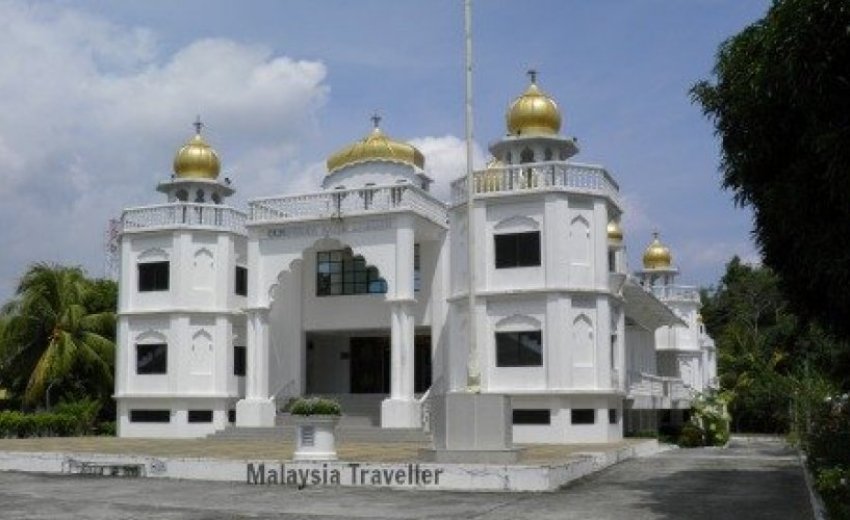The Malaysian Sikh community is the fourth largest ethnic group of Malaysian Indians. It is estimated that over 100,000 Sikhs reside in Malaysia. The Sikh population is the largest here among Southeast and East Asia.
Regular Sikh migration to Malaya (now Malaysia) started in 1873. Some of the earliest settlers from the Sikh community who came to Malaysia were policemen. After the migration, they built the first Malaysian gurudwara in 1873. It was established inside police lines in Fort Cornwallis. The first public Sikh gurudwara was set up in 1903 in the Penang state of Malaysia.
During the British reign of Malaysia, Sikhs held the highest ranks in the military and police. There are as many as 15 Sikh gurdwaras in Kuala Lumpur, more than the number of mosques, despite Muslims constituting the majority of the city's population. It is believed that Malaysian Sikhs are more deeply ingrained in Sikh culture than any other Sikh diaspora. They have been intrinsically incorporated into mainstream society while maintaining their identity.
Let’s go on a Gurdwara trail to the six most exquisite Sikh gurudwaras in Malaysia:
- Gurdwara Sahib, Johor Bahru
In the latter half of the nineteenth century, Sikhs began migrating to the state of Johor. Most of them found work in the Johor Sultan's Guards or in the Johor Police Force. The present site was gazetted as temple reserve land in 1921 upon which the Sikhs constructed their first Gurdwara.
During the Second World War, the Sikhs were expelled from Johor Bahru and migrated to other regions in the neighborhood. During that period, the gurudwara was closed and not in use. In 1957, the second Gurdwara building was constructed at a cost of about RM45,000. This was a two-storey concrete building.
To accommodate the expanding Sikh community, it was necessary to construct a new, larger Gurdwara Sahib building by the 1980s. The present gurdwara sahib was completed and opened to the public in 1992.
- Gurdwara Sahib, Kuala Pilah
With Sikhs migrating to Kuala Pilah, the first gurudwara in the region was built between 1908 and 1910. It had wooden walls and a roof of zinc sheet. By 1933, around 19 Sikh policemen were stationed in Kuala Pilah. They along with the other Sikh community members, came together to expand and renovate the gurudwara. The new design of the gurudwara was based on that of Gurdwara Sahib Mantin. It was opened in 1937 with Akhand Paath (reading and completing the holy Guru Granth Sahib Ji in 48 hours).
As last recorded, around sixteen Sikh families live in the region and participate in all the significant religious occasions for Sikhism.
- Gurdwara Sahib Kuching, Sarawak
In 1910, the Sikh community, a majority of them police personnel and watchmen, decided to build a gurudwara in Kuching. It was inaugurated in 1920. Over the years, the gurudwara has been repaired multiple times. With the Sikh community growing in the region, the building was demolished to build a new one. The three-story brick building has a darbar hall, langar hall, kitchen, library, and office. In 1999, the relics of Guru Gobind Singh Ji which included a handwritten note, kanga or comb, dastar or turban, were displayed in the gurudwara.
As last recorded, around 75 Sikh families residing in the region participate in all the religious festivities at the gurudwara. Usually, the paath or prayers are held at 9:00 am each Sunday.
- Gurdwara Sahib, Labuan
Sikhs have lived in Labuan since the 1860s. Many were employed in the coal mines or the police force. Later generations have achieved success in a variety of fields, and the magnificent appearance of the Gurdwara attests to the Sikh community's affluence in Labuan.
In the 1950s, there was a wooden gurdwara that existed on the site of the present gurdwara. Unfortunately, there are no documents indicating when this Gurdwara Sahib was first constructed. This gurudwara was destroyed in a fire in 1967 but the holy book, the Sri Guru Granth Sahib Ji, however, remained unharmed by the fire, with only the cover slightly damaged. On the same site, the Sikh Sangat constructed a new double-storey wooden building with a zinc roof. The foundation stone for the second gurudwara structure was set on December 9, 1967, and it was officially opened on March 1969.
The Sangat used this Gurdwara Sahib until early 1996 when it was demolished to make way for a new building. The new gurdwara is a two-storey brick structure with a tiled roof. The Darbar Sahib is located on the first floor. The Gurdwara was officially opened in 2000 by the Panj Piyaras. As last recorded, around 16 Sikh families participate in the gurudwara’s religious activities.
- Gurdwara Sahib, Pusing
In 1892, members of the Sikh community in Pusing constructed the Gurdwara Sahib Pusing on three acres of land. After its original construction in 1926, the Gurdwara was repaired on several occasions. On December 31, 1992, a major religious parade was held in Pusing to commemorate the one-hundredth anniversary of the founding of the Gurdwara Sahib Pusing (also known as the Gurdwara Shahid).
The Sri Guru Granth Sahib Ji, the Sikh Holy Book, was carried through the streets of Malaysia by around 2,000 Sikhs from all over the country. The settlement of Papar, located some three kilometers from the Gurdwara Sahib Pusing, served as the starting point for the procession, which was led by the Panj Piare. The occasion saw several kirtan jathas singing religious hymns throughout the evening. The Nishan Sahib was first raised the next morning, on January 1, 1993 (New Year's Day) in Gurdwara Sahib Pusing.
In the early 1990s, the Gurdwara Sahib Pusing underwent considerable renovations. Simultaneously, another Darbar Sahib was constructed a few yards distant from the old gurdwara building to accommodate the large number of guests who wanted to hold religious programs. Since the Pusing Gurdwara Sahib has two Darbar Sahibs, two religious programs can be held at the same time. About 10 Sikh families from the Pusing area engage in the religious events held at the gurudwara.
- Gurdwara Sahib, Rawang
Located right adjacent to the train station, the Gurudwara Sahib in Rawang was built in 1938. Its address "Rawang Tin Fields" illustrates the former economic activity in this area. The present expanded and enhanced structure of the Gurdwara was built in the 1970s. As last recorded, the Sikh community plans to renovate and expand the gurudwara complex even further.
The Sikh population of Malaysia has prospered owing to the emphasis on education, strong family bonds, and communal solidarity. Malaysian Sikhs have worked hard to promote, preserve and maintain their identity, culture, and heritage. The elegant architecture and peaceful ambiance of Malaysian Gurdwaras make them epitomes of holiness, peace, and harmony.

